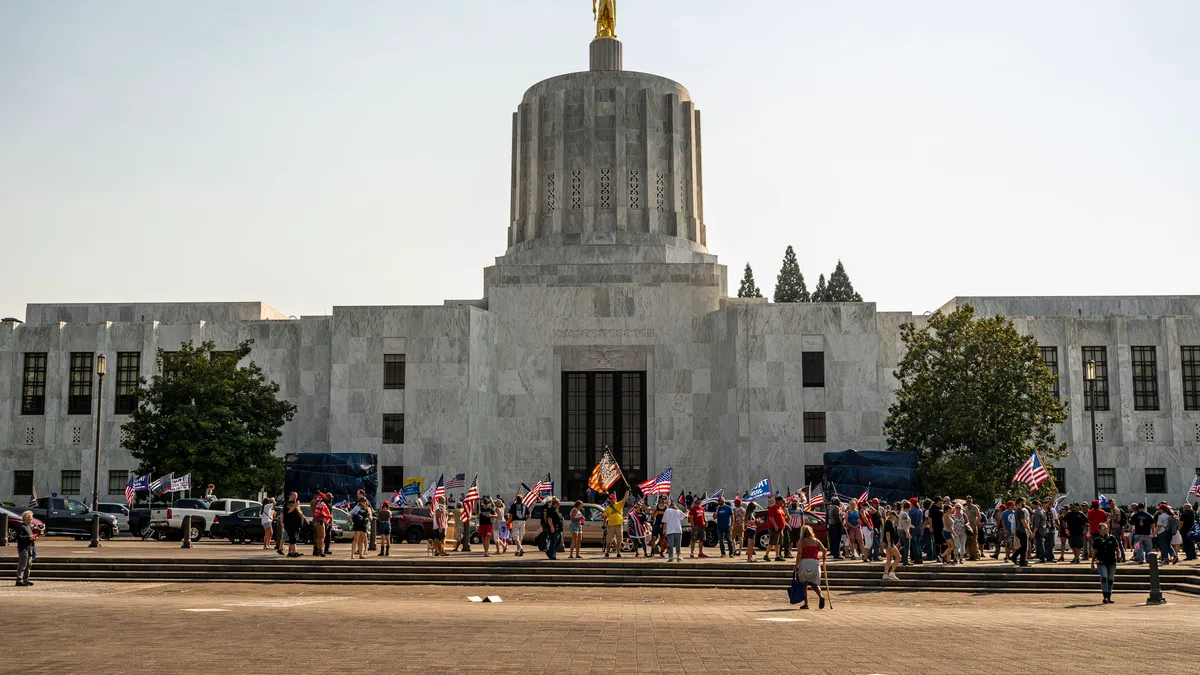Dive Brief:
- Oregon lawmakers on Saturday passed legislation that would require the state's largest utilities to eliminate greenhouse gas emissions from their electricity supply by 2040, making it one of the most aggressive state decarbonization timelines in the country.
- House Bill 2021, which now heads to Gov. Kate Brown's desk, would adopt interim targets of reducing emissions 80% by 2030 and 90% by 2035 for the state's two large utilities, Portland General Electric (PGE) and Pacific Power. The utilities will have to craft plans on reaching those clean energy targets in alignment with their integrated resource planning process, expected in early 2022.
- "This 100% clean by 2040 policy makes Oregon a leader among the states striving to get to carbon-free electricity," Meredith Connolly, Oregon director of Climate Solutions, said. The other two West Coast states, California and Washington, are aiming to decarbonize their electric grids by 2045, "and it was wonderful to see Oregon go from laggard to leader," she added.
Dive Insight:
Lawmakers in Oregon have previously tried to create a cap-and-trade system, but those efforts were quashed after Republican legislators walked out of the Capitol. Republicans largely voted against HB 2021 as well, Oregon Public Broadcasting reported, in part because of concerns that eliminating carbon emissions could put the grid in a vulnerable position.
This bill was the product of months of negotiation between a diverse coalition of stakeholders, including utilities, Connolly said. It applies to PGE and Pacific Power, as well as some electricity service suppliers.
"I do think it certainly helped lawmakers to hear from utilities [that] this ambitious timeline is actually achievable, and from the ratepayer advocate this policy is affordable and will save customers money over time," she said.
The bill could lead to the development of 2,765 MW of new renewables by 2030 by PGE and Pacific Power parent company PacifiCorp, according to analysis conducted by Climate Solutions, Northwest Energy Coalition, and Renewable Northwest. For context, Oregon had 592 MW of solar energy and 3,415 MW of wind energy as of 2019.
HB 2021 also includes a "reliability pause," keeping the door open for regulators to consider granting a temporary exemption to an electric utility if complying with the bill or its clean energy plan could conflict with standards set by the North American Electric Reliability Corporation, or jeopardize grid reliability in other ways.
That element will "ensure stable reliable electricity will always be provided if we clean up the grid, but it's not a get-out-of-jail-free card — it's a temporary reprieve, if required, on this march toward 100% clean [energy]," Connolly explained.
In terms of meeting the 80% emissions reduction by 2030 goal, Pacific Power parent company PacifiCorp is in the midst of its 2020 all-source request for proposals, and recently released its a final shortlist that includes over 3,400 MW of new wind, solar and battery resources, spokesperson Tom Gauntt said in an emailed statement. The utility sees a path to meeting HB 2021's emission reduction trajectory by optimizing its resource portfolio, taking advantage of efficient market operations and expanding transmission to ensure access to low-cost renewables across the West.
PGE Vice President of Public Affairs Dave Robertson said in an emailed statement that the bill's passage is "an important step toward the clean energy future we have been pursuing for Oregon and our customers."
"It provides a clear path for this critical transition while protecting the affordability and reliability of electricity, and it establishes greenhouse gas reduction targets that are in line with the climate goals we set for ourselves late last year," Robertson said.
The utilities now face the immediate task of building out clean energy resources like solar, wind and storage, Connolly said, as well as rethinking the role of demand-side resources on the grid, and working on demand response, microgrids, and local solar and storage to reduce reliance on gas and coal. The other big issues the power sector will need to begin figuring out is building adequate transmission to support that clean energy target, as well as adapting the grid to a more regional market that will help leverage resources across the state, she added.
"Those are all major shifts in how we do this, but they're all possible," Connolly said. "Resource adequacy and reliability are big topics of discussion here and I think what we all recognize — including our partners at the utilities — is they are not insurmountable. They're planning issues."















